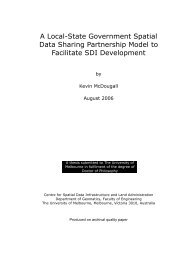Digital Lodgement of Cadastral Survey Data in Australia - Centre for ...
Digital Lodgement of Cadastral Survey Data in Australia - Centre for ...
Digital Lodgement of Cadastral Survey Data in Australia - Centre for ...
Create successful ePaper yourself
Turn your PDF publications into a flip-book with our unique Google optimized e-Paper software.
the compatibility <strong>of</strong> these <strong>in</strong>ternal systems with those from <strong>in</strong>teract<strong>in</strong>g agencies, to provide a quick and easy flow <strong>of</strong> data<br />
between organisations, as there are several other digital systems used by surveyors, the referral authorities and the DCDB<br />
custodian. Although this shows an ef<strong>for</strong>t to shift to a digital environment, the systems are not <strong>in</strong>tegrated, thus limit<strong>in</strong>g the<br />
efficient flow <strong>of</strong> data.<br />
It is important that any attempts to convert manual processes to digital are done with care and consultation with stakeholders.<br />
This can be demonstrated through one approach several years ago. The lead<strong>in</strong>g water authority <strong>in</strong> Victoria requested that<br />
surveyors had to submit all <strong>of</strong> their plans with more than ten lots <strong>in</strong> a digital <strong>for</strong>mat. Although this appeared reasonable, it was<br />
argued that the scheme was not implemented very successfully, as it was designed purely to fit <strong>in</strong> with the water authority’s<br />
requirements, rather than the surveyors’. The surveyors were asked to prepare their plans us<strong>in</strong>g specified s<strong>of</strong>tware, result<strong>in</strong>g <strong>in</strong><br />
some hav<strong>in</strong>g to acquire new s<strong>of</strong>tware. This was deemed to be quite unreasonable, and has made many surveyors skeptical <strong>of</strong><br />
the need <strong>for</strong> digital lodgement.<br />
The <strong>Survey</strong> Mark Enquiry Service (SMES) provided by Land Victoria (the primary government organisation deal<strong>in</strong>g with land<br />
adm<strong>in</strong>istration <strong>in</strong> Victoria) is another example <strong>of</strong> how a digital environment does not necessarily provide the best solution.<br />
Although there are obvious problems such as a lack <strong>of</strong> control marks, many surveyors have reported the program to be<br />
cumbersome to use, with many preferr<strong>in</strong>g to use manual methods. This highlights the fact that any digital system be<strong>in</strong>g<br />
<strong>in</strong>troduced must be user-friendly <strong>in</strong> order to ga<strong>in</strong> the most out <strong>of</strong> a digital environment.<br />
A significant anomaly with the land registration system <strong>in</strong> Victoria is the fact that each plan has two identifiers, be<strong>in</strong>g the<br />
volume and folio, and the plan and lot number. This stems from the <strong>in</strong>troduction <strong>of</strong> the Torrens system <strong>of</strong> title registration, when<br />
paper plans were numbered with special folio numbers permitt<strong>in</strong>g an <strong>in</strong>dex<strong>in</strong>g system to be used to store and access the data.<br />
Theoretically, the volume and folio number is only used <strong>for</strong> storage purposes, and is not a unique identifier <strong>for</strong> a parcel. It would<br />
there<strong>for</strong>e seem logical to elim<strong>in</strong>ate the volume and folio number <strong>in</strong> a digital environment, and rely on one unique identifier. This<br />
needs to be done carefully recognis<strong>in</strong>g that such a change is complicated <strong>for</strong> historical reasons. Land Victoria is implement<strong>in</strong>g<br />
the Spatial Parcel Identifier (SPI) project to rectify this issue.<br />
Although this summary focusses on Victoria, many <strong>of</strong> the other <strong>Australia</strong>n jurisdictions are similar, and thus experience similar<br />
problems. It has been shown that current plan lodgement and registration systems are <strong>in</strong>adequate <strong>for</strong> the demands be<strong>in</strong>g placed<br />
on spatial <strong>in</strong><strong>for</strong>mation today. Although there have been attempts to convert to a digital <strong>for</strong>mat, many systems are still<br />
essentially paper based, and will benefit <strong>in</strong> many ways by the <strong>in</strong>evitable conversion to a full digital environment.<br />
DIGITAL LODGEMENT INITIATIVES IN OTHER JURISDICTIONS<br />
Several jurisdictions are recognis<strong>in</strong>g the benefits <strong>of</strong> shift<strong>in</strong>g <strong>in</strong>to a digital land registration environment. The evaluation <strong>of</strong> these<br />
systems provides a valuable understand<strong>in</strong>g <strong>of</strong> the direction <strong>in</strong> which digital lodgement should head. The jurisdictions that have<br />
been reviewed <strong>in</strong> this paper are the <strong>Australia</strong>n Capital Territory, New South Wales, Queensland, South <strong>Australia</strong>, Western<br />
<strong>Australia</strong> and New Zealand.<br />
<strong>Australia</strong>n Capital Territory<br />
In the <strong>Australia</strong>n Capital Territory (ACT), surveyors are required to lodge their plans <strong>in</strong> a digital <strong>for</strong>mat to two agencies – the<br />
ACT Land In<strong>for</strong>mation <strong>Centre</strong> (ACTLIC), and the Office <strong>of</strong> the Chief <strong>Survey</strong>or. This has resulted <strong>in</strong> 99% <strong>of</strong> all cadastral<br />
<strong>in</strong><strong>for</strong>mation <strong>in</strong>itially lodged <strong>in</strong> a digital <strong>for</strong>m to the ACT Land In<strong>for</strong>mation <strong>Centre</strong>.<br />
<strong>Survey</strong>ors are required to lodge plans <strong>in</strong> digital <strong>for</strong>mat to ACTLIC, <strong>for</strong> submission to ACTMAP, which is the ACT’s digital<br />
cadastral land <strong>in</strong><strong>for</strong>mation system. The surveyor carries out the calculation <strong>of</strong> the data, and then <strong>for</strong>wards the plan to ACTLIC<br />
<strong>in</strong> digital <strong>for</strong>mat, usually <strong>in</strong> a digital exchange <strong>for</strong>mat (DXF) file, or a Microstation draw<strong>in</strong>g file (DWG) <strong>for</strong>mat <strong>in</strong> ACT Grid coord<strong>in</strong>ates.<br />
ACTLIC then validates and approves the data be<strong>for</strong>e <strong>in</strong>sert<strong>in</strong>g it <strong>in</strong>to ACTMAP. The steps taken to update<br />
ACTMAP <strong>in</strong>clude three stages – massag<strong>in</strong>g which names polygons, adds attributes and ensures that all styles <strong>in</strong> the plan are<br />
correct; check<strong>in</strong>g which carries out 18 data <strong>in</strong>tegrity checks; and data transfer, which adds time/date stamp<strong>in</strong>g to each block<br />
allow<strong>in</strong>g <strong>for</strong> <strong>in</strong>cremental updat<strong>in</strong>g (Weaver, 1998).<br />
<strong>Survey</strong>ors are also required to lodge all plans, both <strong>in</strong> digital and hard copy <strong>for</strong>mat, to the Office <strong>of</strong> the Chief <strong>Survey</strong>or <strong>for</strong><br />
exam<strong>in</strong>ation. The exam<strong>in</strong>ation process is carried out electronically us<strong>in</strong>g ACTMAP's cadastral base and data sets <strong>of</strong> <strong>Survey</strong><br />
Control, Road Base, Utilities and Build<strong>in</strong>g Footpr<strong>in</strong>ts. After exam<strong>in</strong>ation, plans are registered at the Registrar General’s Office as<br />
a Deposited Plan (DP). The DP is scanned, and the compilation <strong>of</strong> all DPs <strong>for</strong>ms the DP database held <strong>in</strong> the Registrar General’s<br />
Office (ACTLIC, 1998).







